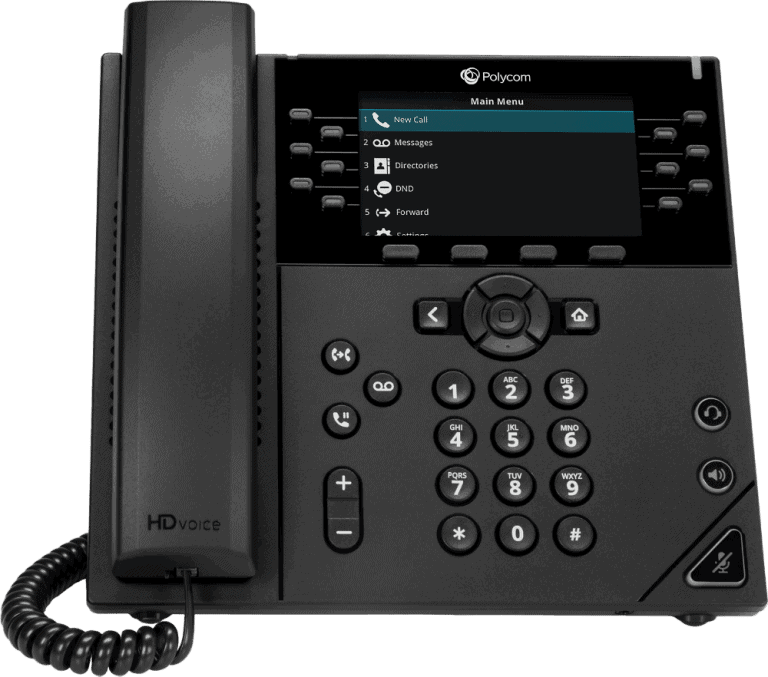What is a Softphone?
Definition, 12 Best Features, Benefits & More
Anyone who has spent time looking into a business phone service has probably heard of a softphone.
Chances are you’ve already asked yourself, what is a softphone? How does it differ from regular IP phones? And do you really need one? Keep reading for the answers to all of those questions, and more.
What is a Softphone?
So, you’ve stumbled across the term softphone during your VoIP research but aren’t entirely sure what it means. It’s pretty simple! A softphone is a software application that’s installed on an internet-connected device and to make phone calls.
Typically, the softphone software is provided by your VoIP provider and is a user-friendly interface that functions much the same way a regular phone would. This interface allows users access to dialing and all the features that come with their VoIP solution.
In general, a softphone can access and enhance all of your VoIP features, something that traditional phones (even with adapters) can’t do.
Now that you know what a softphone is, we’ll take a high-level look at how one works. You’ll be surprised by how simple it is.
How Does a Softphone Work?
Understanding the ins-and-outs of a softphone is surprisingly simple. For most providers, setting up your phone is as easy as following the program’s built-in setup process, which often has you up and running in a matter of minutes.
But first, it’s important to know what the basic requirements of a Softphone are.
Basic Requirements
In order to use a softphone you need two pieces of equipment:
- A desktop computer
- A VoIP headset (or access to a microphone and speaker combination on your device)
A headset is recommended to ensure you get the best possible sound. While you might have great speakers and a device that picks up your voice well, there’s more opportunities for ambient noise to disrupt the sound quality without a proper headset.
We also mention having a desktop computer, but there are plenty of other devices that can access a softphone if you’re not primarily working off of a desktop.
You can use any type of computer (laptop or desktop), a smartphone, or even a tablet. As long as you can connect to the internet all of these options are available to you. Now that you have the hardware you need it’s time to download the program.
Softphone Software
With your devices on hand, you’re ready to get started.
After following the set-up process and implementing your phone settings, the app is ready to go in a matter of minutes.
All you need to make your first phone call is an internet connection.
DSL or Cable Service
The last, but most important, piece of the softphone puzzle is ensuring that you’re connected to the internet. You’ll need a reliable internet connection that can access enough bandwidth to ensure you don’t experience dropped or disjointed calls.
There are a few other technical requirements that need to be considered. These remaining requirements are minor, though, since most modern devices come equipped with the proper support.
Other Technical Requirements
- Softphone’s can only communicate with another device when both endpoints support the same VoIP (Voice over IP) Protocol
- Both endpoints must have at least one common codec
With your program installed, devices ready to go, and a solid internet connection, you can now begin making your Softphone calls and can accessing some of your softphone’s great features.
Standard Softphone Features
Using a softphone gives users a host of options when it comes to features. From an easy-to-use interface to the many build-in caller settings; users can customise it to fit their business needs. Most softphone’s come with your standard telephony features like mute, hold, transfer, and flash as well as online messaging features such as instant messaging.
Beyond those standard features, there are many others to choose from. Below are just are few of the most popular features.
- 3-way calling
- Multiple Call Appearance Lines
- Blind, Warm, and Voicemail Transfers
- Caller ID
- Call Waiting
- Voicemail
- Call Forwarding
- Caller and Calling Line Information
- Call Log
- Call Hold/Resume
- One-click Calling
- Mute and Volume Controls
As you can see, softphones come with all of the features you’d expected, and more. It’s one of the many benefits of making the switch from your old hardwired phone to a desktop app.

Softphone Benefits
Now that you know what features come with your typical softphone setup, it’s time to dive into the other benefits, of which there are plenty. Let’s start with the one that most businesses are most concerned with: cost savings.
Well, the #1 Has Got to Be Cost Savings
Softphones come with serious savings. There are a number of different types that range in price, but almost all of them save you money.
Signing up for VoIP through a provider will usually allow you access to a softphone program for a low cost, at least compared to the cost of hardwiring your office for traditional phones.
Additional Softphone benefits
Still on the fence about choosing a VoIP business phone system? These additional benefits might help you make a decision. They’re just a few of the major reasons VoIP and softphones are growing so rapidly in popularity.
Less Equipment
Softphones require much less equipment than older voice solutions. The copper wiring once required to hook up a landline is no longer required and the costly PBX server installation isn’t necessary.
No Dedicated Line
Softphones are able to efficiently use existing internet bandwidth, negating the need for a dedicated connection for voice communications. The lack of a dedicated line is another major cost savings for your business.
Video Conferencing & Calling
Instead of installing a costly conferencing system for your businesses, a Softphone can handle multi-party conferencing and video calling without an additional costs.
Additional Lines
Add new lines by logging into your dashboard and making the necessary adjustments. You no longer need to hardwire lines into a new space.
24/7 Employee Connectivity
A major benefit of your softphone is being able to take it anywhere. Reinstall your program on a new computer and add it to any additional cell phone. You never have to worry about the cost of moving and reinstalling equipment, it’s a simple program download and you’re back in business.
Softphones Vs. Traditional Phones
We mentioned the cost savings compared to traditional phones. Other than that, what are the major ways that softphones differ from traditional phones?
Upfront Costs
In order to install a traditional phone line, you have to purchase or lease the phones themselves. This can be a huge upfront cost for your business.
The upfront costs don’t take into account how much you might spend to maintain them during their lifespan, or even replace them eventually. With a softphone, there is no costly hardware to worry about and you can take it with you should you need to move offices.
Remote Capabilities
If you have employees working from home, softphones can be a life-saver. The program or app can be accessed from anywhere in the world, users can initiate call forwarding to their mobile device, and settings can be changed at the click of a button.
Your employees never have to worry about missing a conference call again.
Unified Communications
Having one platform across all of your employees not only makes it easier for them to communicate with each other, but it simplifies how they connect with your clients. Scheduling conference calls on the go, sending instant messages to each other during important calls, and voicemail-to-email options open up a whole new world of communication that traditional phones just can’t compare with.
Softphones Vs. Hard Phones
Now you know what a softphone is and the many amazing benefits that come along with the program. The next question on your mind might be, what’s the difference between a softphone and a hard phone (IP Phone)?
Firstly, the two aren’t really competitors. They both highlight the amazing features of VoIP and make your unified communication system run smoother; at a much lower cost compared to your older phone lines.
A hard phone is exactly what it sounds like; a physical phone that provides you the same access that a softphone does for your VoIP system. Generally, these two things work in conjunction with one another to provide an exceptional communication solution.
When it comes to softphones, it’s clear that they’re an incredible addition to any VoIP solution. Whether it’s the benefits and features or cost savings that you’re interested in, the use of a softphone alongside your VoIP solution is guaranteed to meet the needs of any business.

